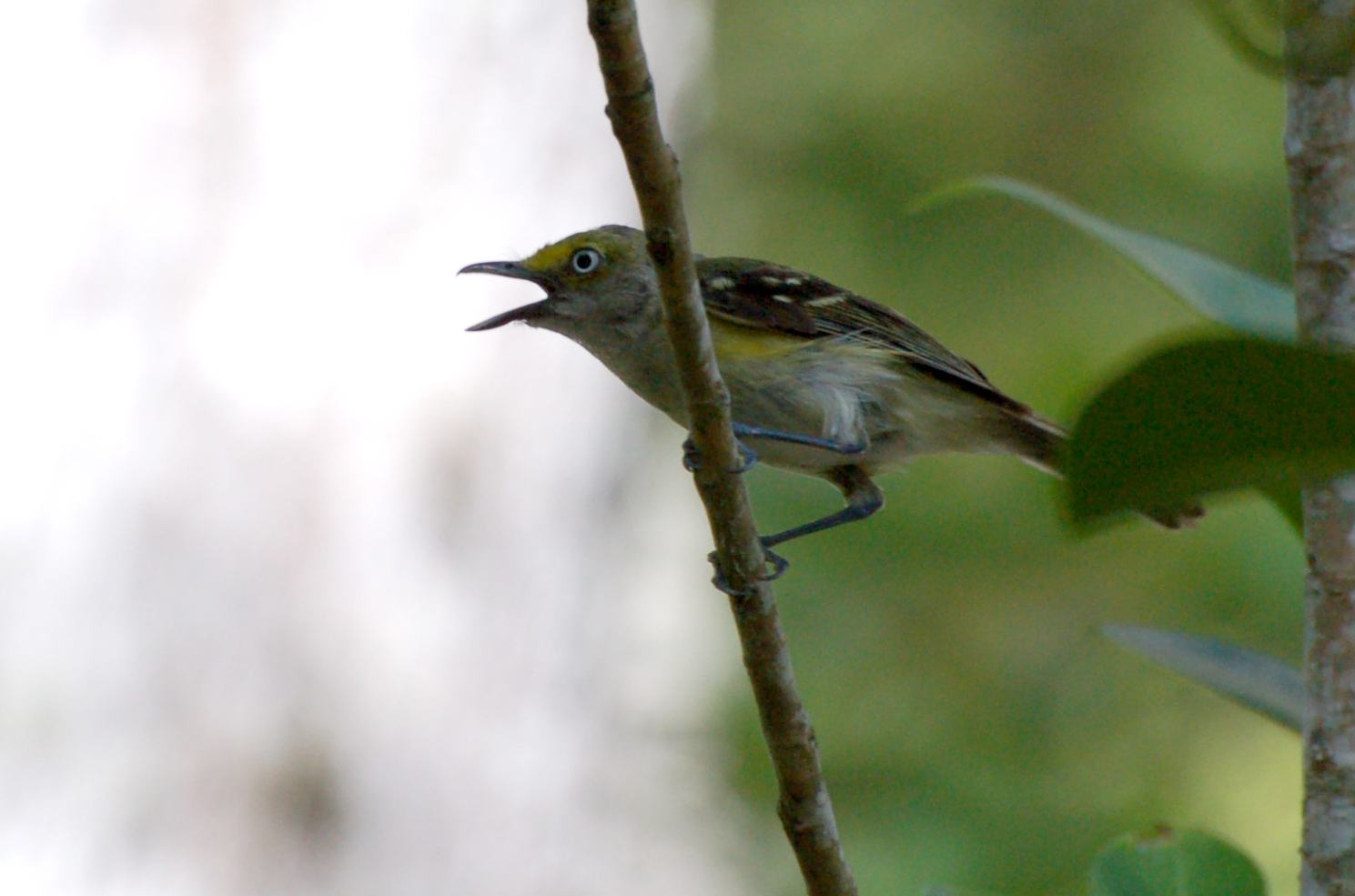- White-eyed Vireo
Taxobox
name = White-eyed Vireo
status = LC | status_system = IUCN3.1

regnum =Animal ia
phylum = Chordata
classis = Aves
ordo =Passeriformes
familia =Vireonidae
genus = "Vireo "
species = "V. griseus"
binomial = "Vireo griseus"
binomial_authority = (Boddaert, 1783)The White-eyed Vireo, "Vireo griseus", is a small
songbird . It breeds in the southeasternUSA fromNew Jersey west to northernMissouri and south toTexas andFlorida , and also in easternMexico , northernCentral America ,Cuba and theBahamas .Populations on the US Gulf coast and further south are resident, but most
North America n birds migrate south in winter.This
vireo frequents bushes and shrubs in abandoned cultivation or overgrown pastures. The grass-lined nest is a neat cup shape, attached to a fork in a tree branch byspider webs. 3-5 dark-spotted white eggs are laid. Both the male and female incubate the eggs for 12 - 16 days. The young leave the nest 9 - 11 days after hatching.The White-eyed Vireo is 13 – 15 cm in length. Its head and back are a greyish olive, and the underparts are white with yellow flanks. The wings and tail are dark, and there are two white wing bars on each wing. The eyes have white irises, and are surrounded by yellow spectacles. Sexes are similar.
The White-eyed Vireo's song is a variable and rapid six to seven note phrase, starting and ending with a sharp "chick".
During the breeding season, the diet of this species consists almost exclusively of
insect s, primarilycaterpillar s. In the autumn and winter it supplements its diet ofinsect s with berries.Subspecies
Several
subspecies are recognized for the White-eyed Vireo. Geographic ranges for subspecies are not entirely clear.The northern subspecies, "V. g. noveboracensis", occupies most of the range of this species and is fully migratory. This sub-species is larger and has more brightly colored plumage than all other subspecies.
The resident southeastern
coastal plain race, "V. g. griseus" is a slightly smaller and duller colored subspecies. It does not typically migrate out of its breeding range in the winter.The resident
Florida Keys race, "V. g. maynardi", is greyer above and whiter below, and the south Texan "V. g. micrus" is like a smaller "maynardi"."V. g. bermudianus", is endemic to
Bermuda . This has shorter wings and a duller plumage. Along with other endemic and native Bermudian birds, it was threatened with extinction following the loss of 8 millionBermuda cedar trees in the 1940s, and is now quite rare.References
* Database entry includes justification for why this species is of least concern
External links
* [http://www.birdspix.com/ARCHIVE%20SPECIES%20PAGES/White-eyed%20Vireo.html White-eyed Vireo Photographs] - John S. Schwarz Bird Photography
* [http://www.bermuda-online.org/fauna.htm Bermuda Online: Bermudian Fauna.]
* [http://www.tamug.edu/cavebiology/BeCKIS/overseas.htm Cave Biology.Com: Bermuda.]
* [http://www.birds.cornell.edu/AllAboutBirds/BirdGuide/White-eyed_Vireo.html White-eyed Vireo Species Account] - Cornell Lab of Ornithology
* [http://sdakotabirds.com/species/white_eyed_vireo.htm White-eyed Vireo - "Vireo griseus"] - USGS Patuxent Bird Identification InfoCenter
* [http://www.sdakotabirds.com/species/white_eyed_vireo_info.htm White-eyed Vireo Information] - South Dakota Birds and Birding
* [http://members.tripod.com/caddobirds/images/WhiteEyedVireo060408-1.jpgPhoto-High Res--(Close-up)] ; [http://members.tripod.com/caddobirds/apr_06_banding.htm Article] - members.tripod.com–"Bird Banding at Caddo Lake"
Wikimedia Foundation. 2010.
